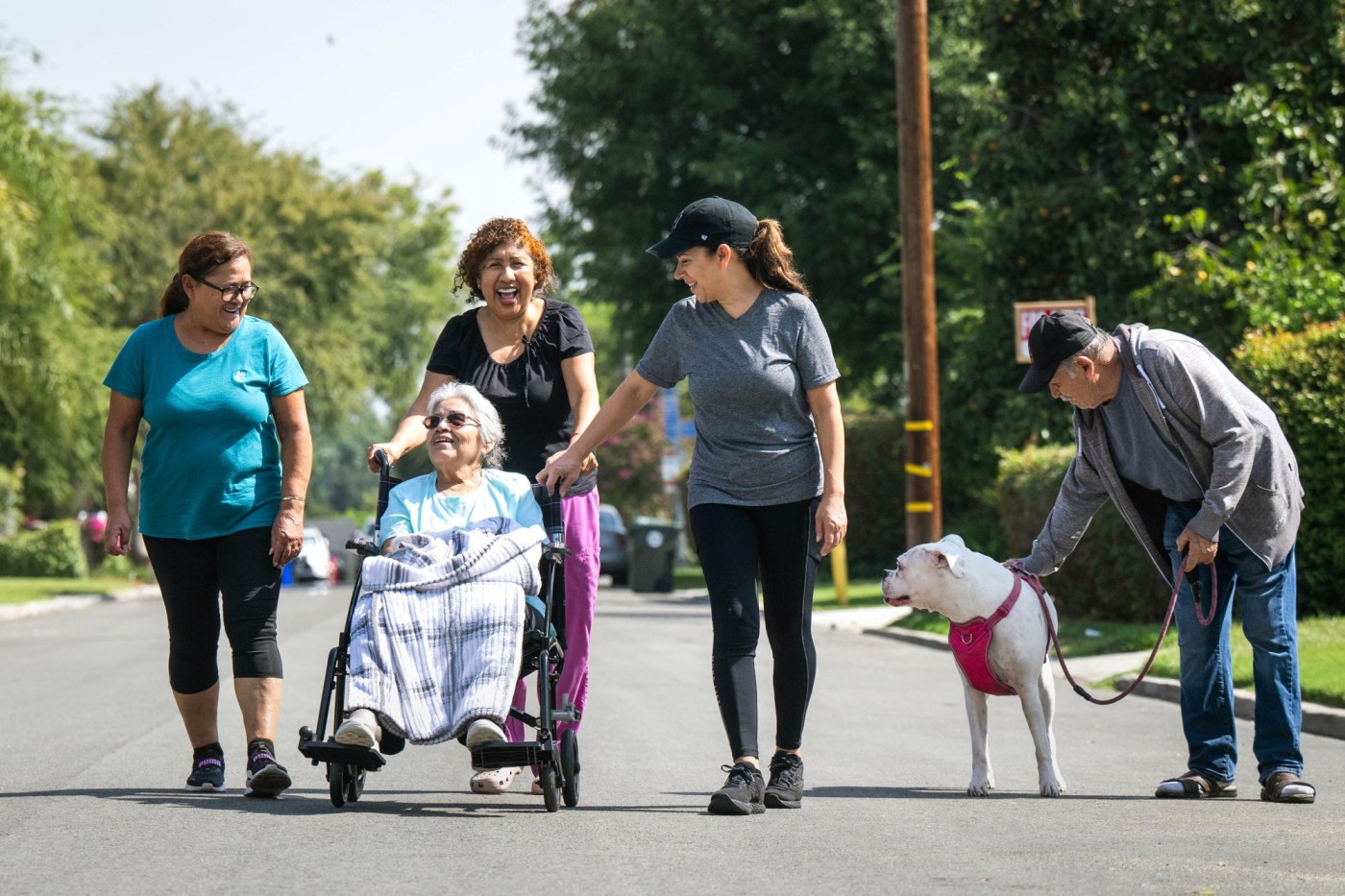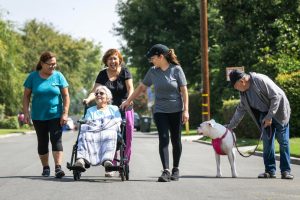
What some caregivers have learned caring for ill loved ones
“It’s not the most comfortable moment that I’m having, but there are these radical lessons.”
That’s how performer/writer Chris Wells describes the experience of moving with his husband from New York back to his childhood home in Lancaster, Calif. What was intended to be a short-term visit to help settle his mother into a retirement community has been extended and complicated by her frailty, and the challenges of untangling a complex web of social and medical services.
And then there’s Elizabeth Aquino in Los Angeles, who has accumulated more than a quarter-century of lived experience as a full-time caregiver since her daughter was diagnosed with a seizure disorder. Aquino has become well-versed in the ins-and-outs of accessibility and disability rights. She has successfully advocated for everything from changing tables in high school restrooms to the use of medical marijuana for seizure treatment, but, even after all this time, much feels beyond her ken.
“People say they couldn’t do what I’m doing,” she says, “I can’t do it either. I am not amazing. I’m just winging it. I’m alert all night long. It’s so scary.”
Caregiving is common
According to CDC estimates, during any given month, nearly one-quarter of all adults over the age of 45 in the United States will have given care or assistance to a loved one in need of help. Additionally, an estimated 5.4 million children and teenagers aged 18 or younger provide significant assistance or care to a family member with a chronic illness, disability, mental health condition, or frailty due to aging.
Caregivers may be tenth graders studying for midterms, or young adults just starting a career. They are spouses, partners, friends and relatives. Those in the so-called “sandwich generation” are simultaneously caring for a loved one, while also tending to young children. Some, like Aquino, are in it for the long haul, while others, such as Dr. Feylin Lewis, assistant dean of Student Affairs at Vanderbilt University School of Nursing, have emerged from a difficult period, but are irrevocably changed.
Just 11 years old when she assumed care for her own mother, Lewis has spent her adult life researching and advocating for young caregivers. “We tend to gravitate toward our lived experience,” she says, “and want to help others.”
Losing yourself in caring
I was 30 when my 57-year-old father received a diagnosis of early onset Alzheimer’s disease. I left my friends and a budding writing career in California, and returned to New Mexico to partner in caring with my stepmother, a process I often described as “being only hands for doing and feet for running.” My own self-identity had begun to blur long before Dad forgot my name.
As I sat down to consider how we might “care for the caregiver,” it was this feeling of disappearing that came back to me. It’s a given that caregivers always need more time. Of course, more money would help. Improved, accessible, affordable medical and social services would be transformative.
But what can you do today? Right now? Get to know them. Understand what they’ve set aside, given up, and postponed. It’s likely that, one day, you also will be a caregiver.
“I had to accept that my work-in-progress was going to be in progress for many more years,” says writer Bruce Bauman. Since 1995, Bauman’s wife, artist Suzan Woodruff, has undergone dozens of surgeries for chronic oral cancer.
During the last five years, he has been a near full-time caretaker. “There was a long period where Suzan said she didn’t know if she’d paint again, that she had no inspiration. I felt like both of us were dying inside when she said that.”
Bauman made it a priority to write a little each day or “at the least sit with my book and ponder.”
Kate Washington, author of “Already Toast: Caregiving and Burnout in America,” who was mother to two elementary school-aged children, as well as primary caregiver to her husband during his bout with cancer, might refer to this practice as “keeping one’s flame alive.” It’s an important strategy for holding on to your own individuality. For Kate, the one thing that made her feel like herself was red lipstick.
While a writing notebook or a tube of Ruby Rose might link back to the before time, “claiming the role and the title of caregiver can be relieving for some people,” Washington says. “Oh, this is why things feel so hard. Because I have a 24-hour-a-day job that is unpaid and largely unacknowledged.”
Recognize that it’s a heavy load
Acknowledging the mental and physical load of the caregiver is helpful for those taking on this primary role, but it’s also important for those hoping to support the caregiver.
Perhaps you’ve never considered that the caregiver often functions as a giant household hard drive, responsible for remembering all appointments, medications, bills, repairs and meal planning.
“Providing emotional support to a distressed partner while not dumping your own distress is caregiving,” says Washington. “Researching this rare disease is caregiving.”
She points out that advocacy and financial support are caregiving, as is the “kin work” of maintaining connections with extended family and other social relationships.
“I feel like we barely talk about this moment,” says Chris Wells, “I think it’s because it culturally falls under the umbrella of women’s work and so it’s not discussed as, like, this huge deal that is going to come along, and you’re not going to be ready, and it’s going to rock your life in a real profound way.”
Having an awareness of this often unseen work is a good first step for family members and friends who wish to be of use.
‘I am a caregiver’
Defining the job of caregiver can be a personal and revelatory process and might offer ways to take a little more care of yourself.
“You have to step back and make a decision,” says Patti Davis, whose experience caring for her father, Ronald Reagan, informed her book, “Floating in the Deep End: How Caregivers Can See Beyond Alzheimer’s.” “I’m in this, too. I’m important, too. Things can fall into place as a result of that decision. It doesn’t mean you will be freed of your responsibilities, but once you decide you’re in the game, too, you can begin to let go.”
Letting go means giving up control; giving up the idea that “no one can do it as well as I will.” Letting go might be leaving the dishes in the sink, might be relying on frozen pizza, it might be opening up to the possibility of more help. It might mean letting go of feelings of shame or guilt.
“When I’m away from her, I sometimes catch myself enjoying life and I think my poor mother is suffering right now,” says Elsa Florez. “Her spine is literally collapsing and so her body is being crushed every day.”
Florez, who has been caring for her mother for two years, recently stepped down from her job as assistant to Father Albert Bahhuth at Holy Family Church in South Pasadena.
“I try to stay busy,” she says, “but you still have that nagging thing. How long is mom going to last? Should I be with her? What am I going to miss? Am I going to regret anything?”
Stuck in the in-between
Absence may spawn feelings of guilt, but so, too, may the sense of being too present. You may be struck by the disconnect of parenting a parent or have what might feel like an insensitive reaction. “There were some things I could not unsee and still cannot,” says Kate Washington. “A therapist told me once that disgust is a core emotion and it’s not something you can reason yourself out of.”
At moments such as this, it’s important to find a way toward self-compassion. Doctor Pooja Lakshmin, in her book, “Real Self-Care,” suggests cultivating “dialectical thinking,” which means acknowledging that two opposites can be true at the same time. You love your mother, but realize you cannot care for her alone.
“Real self-care is still work,” Lakshmin writes, “But it’s less about adding something to your list and more about seeing your place in the world, your family, and your relationships differently.”
Opportunity for emotional healing
The response “yes, and…” is a technique used in dialectical thinking, but also in improv theater games. It’s a phrase that honors the simultaneous existence of a multitude of conflicting ideas, and one that recognizes the value of each player in a scene. “Yes, and…” opens to possibility.
“There’s this tension,” says Chris Wells. “I don’t want to be here. I don’t want to be with my mother. It took Herculean effort to get out of here, to be a working artist. And now, my husband and I are sleeping in the bedroom where my brother and I slept in bunk beds, and I’m just aware of those contradictions. And the other thing is, it’s also incredibly healing.”
The work of caregiving may open exploration of hardwired behavior and unexplored or unresolved hurt, but it can also offer unexpected shifts of perception.
“Mom was always busy with the next baby and the next baby,” explains Elsa Florez, one of 10 siblings, “Now, we see she’s cold and we put her socks on — she’s our baby now. Even though I didn’t feel that nurturing from her — at least not that I can remember — I want to give that to her.”
Getting help for the helper
Acknowledging the emotional complexity of the role of caregiver is important, but so, too, is understanding the very physical day-to-day tasks related to direct care and household upkeep.
“There is no road map, no play book,” says Paolina Milana, community engagement and program specialist at USC’s Family Caregiver Support Center. The center, associated with the USC Leonard Davis School of Gerontology, provides services for family caregivers, including information and referral, support groups, and educational workshops for those in Los Angeles County. Caregiver California offers similar services for those living throughout the Golden State.
“You don’t realize all the legal and medical stuff you need to have in place,” Milana says. “Our consultants can look at your situation and help create a plan.”
You may be entitled to paid respite care or an hourly wage as a family caregiver. Learning about the benefits available to you through insurance or other services is a first step to framing a supportive scaffolding for the days ahead.
Further support is available through the medical community. “Find a doctor who is compassionate and a good communicator,” Bruce Bauman advises. “Ask as many questions as you can think of.”
“As soon as possible,” he recommends, “find a therapist for you and the patient. I could not have given my wife the emotional and physical support that was needed without guidance from my mental health team. Family and friends can only do so much.”
Of course, family and friends can do a lot, but they will need guidance. It’s important to set expectations and boundaries. A family meeting with a brief agenda can be a place to set goals and make plans. Set a clear objective and take notes to ensure clarity. People want to help, but they are often unsure how to begin. A caregiver may designate one friend or family member to be in charge of meal trains or task lists. Those in the support circle are encouraged to volunteer to coordinate aspects of care.
Kate Washington remembers friends who texted offers to pick up groceries or other necessities and specified that, if required, the goods would be dropped on the porch by day’s end. “The magic words,” she says, “were no need to respond.”
For those wishing to help a caregiver, the need to respond is sometimes hard to resist. We might jump in with advice or preface all our conversations with “have you tried…” As well-meaning as this behavior may be, it might not be the best way to nurture your friend or family member.
“Be open, sit in that space with your friend,” says Dr. Feylyn Lewis. “You don’t have to be an expert. You just have to be someone who cares and listens and doesn’t hog the space.”
“How do you do it?” It’s a well-meaning question, but there is no real answer.
“I don’t know,” Patti Davis says. This phrase became her mantra. “We don’t know what’s going to happen in life and we don’t know how we are going to feel about it when it does happen.”
Elizabeth Aquino credits the support of her fellow caregivers and her “absurdist streak” for getting her through the darkest times. “It’s radical acceptance,” she says.
For Elsa Florez, recognizing the similarities and differences between herself and her mother are key. “I don’t need a massage, a pedicure, a manicure,” she says. “I need to be, in my mind and my heart, at peace. And I think the way I do that is I embrace who I am.”
Where can you find support?
Information about becoming a paid caregiver (through Medicaid) for a family member.
Organizations
AARP: General resources, fact sheets, and a vast trove of information pertaining to almost any care situation.
Alzheimer’s Los Angeles: For those in Los Angeles County, caring for loved ones with Alzheimer’s or other dementia. You’ll find a variety of programs, support groups and educational resources as well as advocacy opportunities.
Alzheimer’s Association Orange County
American Association of Caregiving Youth: Information and resources for young caregivers.
California Department of Social Services: Information about local programs including home care, respite, and in-home care.
Caregiver Action Network: Advocacy, information and caregiver support from caregivers.
Caregiver California: Searchable, statewide support group and service locator.
Caring Across Generations: Get involved with advocacy work on behalf of caregivers and learn about legislative priorities.
Family Caregiver Support Center at USC: Serving Los Angeles County, the center offers referrals, resources, respite, support groups and help with legal, medical and financial planning.
HFC (Formerly Hilarity for Charity): Founded by Laurel Miller Rogen and Seth Rogen, this organization provides grants for respite care, educational resources, support, information and a few laughs to support brain health and those caring for loved ones with Alzheimer’s disease and other dementias. Also, excellent advocacy and engagement opportunities for young caregivers, and high school and college students.
National Alliance of Caregivers: An extensive collection of resource lists, research results, information, advocacy opportunities, as well as a library of downloadable guides.


